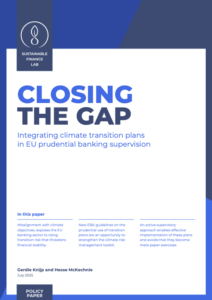Prudential transition plans: A supervisory tool for climate risk management.
Misalignment with climate objectives, exposes the EU banking sector to rising transition risk that threatens financial stability. A new SFL Policy Paper, written by Gerdie Knijp (SFL) and Hesse McKechnie (Sustainable Finance advisor and fellow to the Erasmus Platform for Sustainable Value Creation at Rotterdam School of Management, Erasmus University), explores how the new EBA guidelines on the prudential use of transition plans is an opportunity to strengthen the climate risk management toolkit. The paper provides eight recommendations for supervisors to enables effective implementation of these plans and avoid that they become mere paper exercises.
Transition plans outline how organisations intend to support the shift to a sustainable economy. They offer a strategic lens to assess long-term climate risk, complementing existing tools like scenario analysis and stress testing. By evaluating the misalignment of banks’ portfolios with climate goals, transition plans help identify exposure to credit risk, but also market, legal, and reputational risks.
However, implementation challenges persist. Banks may lack incentives to lead the transition, fearing short-term lost profit and market share. The supervisor will have to take an active approach to ensure effectiveness.
The supervisory responsibility is anchored around their mandate to maintain the stability of the financial system under a range of scenarios. This paper argues they must take the net zero objective as a given and use transition plans to assess risk under both orderly and delayed transition scenarios. We propose a set of supervisory actions to achieve this:
- Ensure robustness of the transition planning process itself by assessing misalignment and by tracking progress against targets over time
- Integrate transition plans into broader microprudential supervision by challenging business model sustainability and using capital charges
- Integrate transition plans into macroprudential supervision and other supervisory actions.
There is a window of opportunity, but it is closing in on us. The future is here already.
For more information, contact g.knijp@uu.nl, or read the full paper below.



